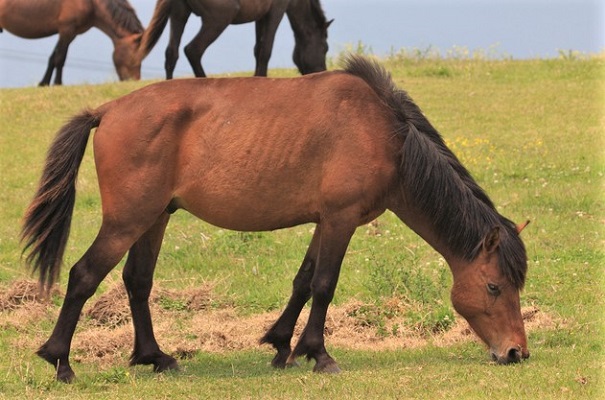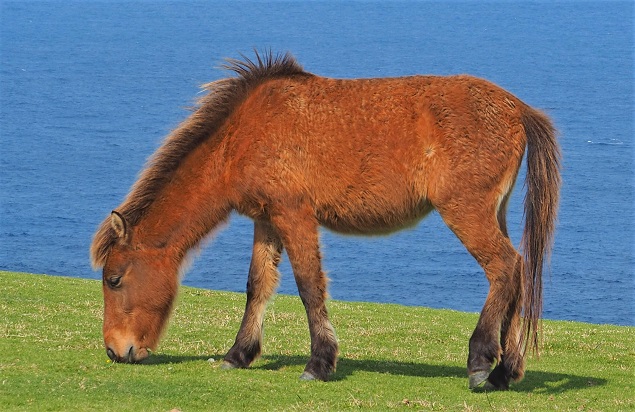Japan is home to some rare and unique breeds of horses. There are eight Japanese horse breeds native to the country, each that began without being crossbred to any foreign breeds.
The eight native Japanese horse breeds are the Hokkaido Washu, Kiso, Noma, Misaki, Taishu, Tokara, Miyako and Yonaguni. The breeds share several similarities, including that they are all technically ponies. They are all known to be hardy horses, with excellent endurance.
For reference, here is a map showing where all the native Japanese horse breeds originate from:

Source
Here are the eight rare Japanese horse breeds.
1. Hokkaido Washu

Also known as the Dosanko, this breed is native to the eastern coast of the Japanese island, Hokkaido. They are descendants of several local breeds that were imported from Tohoku during the 15th century.
The Hokkaido Washu breed stands between 12.2 to 13 hands tall. They are extremely sturdy, capable of surviving tough conditions. The breed comes in just about every solid color. Many roam freely in grazing areas and are only rounded up once a year; some are kept in stables.
Hokkaido Washus are the most popular of all the native Japanese horse breeds. There are currently around 3,000 of these horses. They are popular for driving, trail riding, and packing, with some being natural pacers.
2. Kiso

JenJ Payless2 / Shutterstock.com
Native to Honshu, Kiso is a rare horse breed that can trace back to over 1,000 years ago. They were originally used as warhorses before being bred with larger western breeds, leaving only a small strain of purebred horses set to be castrated.
One purebred horse escaped castration, allowing the breed to survive. Today, the Kaida mura in Kiso County, Nagano Prefecture works to preserve the Kiso breed. There are currently only around 100 Kiso horses.
The Kiso horse stands around 13.2 hands tall. They have sturdy builds and are often bay, gray or chestnut. Many Kiso horses exhibit primitive markings, such as a dorsal stripe. Today, they primarily do riding, agriculture work, and driving.
3. Noma

Includediin our list of smallest horse breeds, the Noma breed originates from Shikoku island, specifically Noma county. Descendants of Mongolian stock, the breed originated in the 17th century.
Noma horses were originally packhorses, traveling across steep mountains and rocky countryside. Though they once flourished, their numbers dwindled when it was forbidden to breed them with western stock. There are less than 100 Noma horses; however, The Noma Pony Preservation Society works to promote and preserve the breed.
The Noma breed stands between 10.1-10.3 hands tall. They are most commonly bay, chestnut, or brown in color. Noma horses are primarily riding mounts for children.
4. Misaki

mokokomo / Shutterstock.com
The Misaki breed inhabits the Cape of Toi in Kushima City, Miyazaki Prefecture. They are descendants of horses originally from China that came to Japan nearly 2,000 years ago.
For hundreds of years, Misaki horses were popular for farm work and also as packhorses. In 1697, a ranch was established at Cape Toi that rounded up feral Misaki horses, breeding them for the military and agriculture. Sadly, their numbers saw a significant decrease after WWII, as there are now only around 100.
Misaki horses stand around 13.2 hands tall and are mainly bay, black, or chestnut. Today, the majority of these horses live in feral herds in Cape Toi in a national park. They are a designated National Natural Treasure and a favorite among tourists.
5. Taishu

Source
Originally from Tsushima in Nagasaki Prefecture, the Taishu horse traces all the way back to the 8th century. They commonly were choices as a packhorse and for hauling timber.
Taishu horses have calm dispositions and are easy to handle, with strong builds. They stand around 12-14 hands tall and are commonly bay, black, or chestnut in color. Today, they are common for riding, driving, and as pack horses.
The Taishu Horse Preservation Association works to protect and preserve this rare breed. However, there are currently less than 100 Taishu horses in Japan.
6. Tokara

Photo by TANAKA Juuyoh (田中十洋) (Flickr)
Native to the Tokara Islands, Tokara horses were first discovered in 1952 by Professor Shigeyuki Hayashida of Kagoshima University. Around 10 horses were first brought to the islands in the late 1800s for transportation and agricultural work.
In the 1940s, the number of horses was at its highest, as they were popular among natives of the islands and were part of local culture. Unfortunately, their numbers significantly fell after WWII. As the use of machinery grew, the horses were taken to Iriki Farm and Mt. Kaimon. In 1974, just one Tokara remained on the islands.
Tokara horses stand around 12-14 hands tall and are generally brown, black, chestnut, bay, or roan in color. To protect the breed, they live at Nakanoshima, where they roam freely. There are only around 100 Tokara horses; however, they are a designated Prefectural Natural Treasure.
7. Miyako

The Miyako is an ancient breed that has traditionally been bred in Okinawa. They have a long history working in farming, including plowing sugar cane fields and also as transportation.
At one point, the Miyakos numbers were in the thousands. In the early 1900s, larger European and American breeds were mixed with Miyako horses to increase their size. However, after WWII, their numbers plummeted. Though they are a Prefectural Natural Treasure, there are only around 20 Miyako horses.
Miyako horses stand around 14 hands tall, though originally, the breed was closer to 11 hands tall. They have a hardy build and are typically bay, dun, or chestnut in color. The current remaining herd is popular as a tourist attraction.
8. Yonaguni

skywings00 / Shutterstock.com
The Yonaguni horse is the most ancient and purest breed of the eight native Japanese horse breeds. Many believe they trace back nearly 2,000 years to the southern islands of Japan.
Since ancient times, the Yonaguni would carry rice and sugarcane around the island. Today, two herds of about 100 Yonaguni horses roam freely on the scenic Yogauni island. The people of the island protect the breed through the Yonaguni Pony Society.
Yonaguni horses stand around 11 hands tall and are primarily chestnut in color. They are hardy a breed and have become a favorite site among tourists. They are also a designated Natural Monument of Yonaguni.
Source: horseyhooves.com








